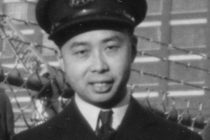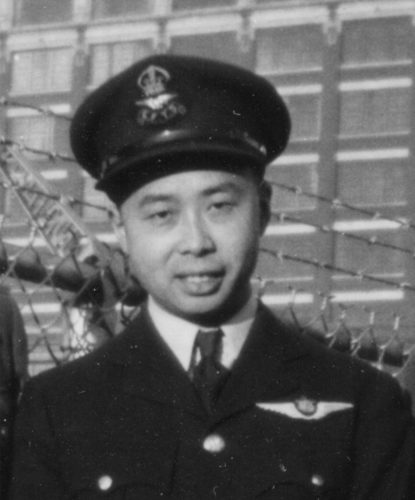
While still in high school, Robert Shun Wong obtained his pilot’s licence. In 1936, he built his own plane from a blueprint that he bought. Working with his younger brother Tommy S Wong they constructed the plane from a car engine, wood and canvas.

He obtained an aeronautical engineering degree in the U.S., and came back to Canada to train new pilots for the war effort. He was based near Windsor, Ontario.
Below is a story on Robert and his brother that was published in the Toronto Star newspaper on June 7, 2015.
When the Wong brothers soared over Toronto
By ANGUS SKENE
Special to the Star
Sun., June 7, 2015
A plane, a loop, a stall, a spin. The pilot hurtling, struggling, diving and crashing through the trees. A screaming mother, glass flying, tremendous noise — then silence. A dead pilot, an injured passenger, a plane embedded in the side of Mrs. Langan’s lovely home at No. 2 Fallingbrook Woods. It was a light green Cesna 140 owned and operated by Central Airways out of Toronto Island. Unspent fuel was slowly pouring into the open basement window.
Central Airways was for many years a respected flight school and charter air company. Fortunately, the 1955 crash that claimed the life of instructor Terrence “Terry” Kenny — with the plane falling right through the leafy Fallingbrook neighbourhood off the east end of The Beaches — was highly unusual in their decades of business.
But Central itself was kind of unusual.
Robert Wong was born in a wood-frame bunkhouse in Nanaimo, B.C., in 1917. His father managed Chinese work crews for the local coal mines, and his men — about 20 of them — shared the bunkhouse with Robert’s mother, father, sisters and brothers. Almost all of the men were surnamed Wong, but that didn’t mean they were related. It just meant they came from the same sleepy farming region back in southern China as Robert’s father did.
Robert was about 10 months old when the Red Baron was shot down, and was 10 years old when Charles Lindbergh flew solo across the Atlantic. Aviation was everywhere, and Robert was caught up in the craze, building so many model airplanes that the local department store set him up in the toy section as an enticing gimmick for the other kids.
By then, his happily married parents had 12 kids and were living in Vancouver’s Chinatown. Like most Chinese people in Canada back then, his father was unable to work mainstream jobs, and so he worked for himself.
After not so successfully running a rooming house, he ran a pig farm on the old tidal flats at the end of the Vancouver trolley lines. Today, Robert’s old neighbourhood is infamous for drugs and prostitution, but while his Chinatown had it’s drunks and gambling dens it also had families: kids playing tag in the alleys, climbing fire escapes to after-school Chinese lessons, sneaking into the movies and collecting dimes from the visiting American tourists.
Robert went to the public tech high school across town. He was often hungry, saving his lunch money for flying lessons. One spring day, he sent away for plans for his very own plane — a Pientenpol Sky Scout. It was a wood-and-fabric contraption powered by a car engine — a big model airplane that flew.
He and his younger brother spent two summers cutting the wood and gluing the pieces together while his sister, his mother and her friends spent a week sewing the fabric for the fuselage. By August of 1936, CF-BAA registered to R. S. Wong of Vancouver took off into a clear blue sky. Robert was 17 and solo in his own single-seat, single-wing aircraft.
Robert and Tommy found surprising support from the wider community in a time of anti-Chinese prejudice. They hiked off to Rexwell Lumber on Main St., and the nice folks at the local Boeing plant gave them advice and the use of their industrial sewing machines. The old car engine came from a local wrecking yard, and a nearby mechanic helped Robert ready it for airplane use — he even let Robert store the highly flammable wood and fabric plan in his garage.
No doubt the brothers faced discrimination, but they were pushing their lives out into a wider world than their parents would ever know.
Soon, Robert was at St. Louis — Lindbergh’s home town — getting a bachelor’s degree in aeronautical engineering at America’s first flight school, Parks Air College. His education trumped that of his sisters, and one had to drop out of school and open a Toronto fruit store to pay his college fees. By 1940, he was a graduate and with World War II in full swing he returned to Canada to train pilots.
He did Elemental Training, which was the first eight weeks for young air force hopefuls. He taught them manoeuvres, and how to land, read instruments and navigate cross-country. About a quarter of them failed.
Based at Windor Airport, he was part of an immense and important program that saw more than 130,000 British Commonwealth aircrew trained on the safe and distant airstrips of Canada. When the war ended, figuring no one would hire them for mainstream aviation work since they were Chinese, he and Tommy bought two surplus planes and continued training pilots.
Wong’s Air School opened in 1945 at Barker Airport, one of a clutch of small, grass airfields on the flat, high land at Dufferin and Lawrence. In short order, a fire burned the hanger and destroyed their planes. But with their insurance money, they soon regrouped and headed south, taking a lease with the Toronto Island Airport.
Re-christened Central Airways, their company offered lessons, charters and sales of new and used planes. Old-timers told them there was no money in teaching, but things took off. Robert managed the business and Tommy taught flying and handled the money.
Used to marginalization, they thought their business would attract mainly Chinese kids who wanted to fly in China and fight the Communists. But Canada was changing, and Robert discovered he had a gift for marketing. He offered cheap ($3) introductory flights with the idea that once people flew, they would want to do it again.
And they got everyone. Teenagers, stenographers, polio victims – the lot. They got a surprising number of girls and women — about 10 per cent of their business some years. Robert used the women pilots to get coverage the papers, along with stunts like taxiing up Yonge St. in Richmond Hill to help open a Dominion Store. Yes, the cute little yellow plane they were in was for sale, and of course if you want lessons here’s our number: Walnut 9374.
By then, almost the entire Wong family was in Toronto. Their aging father used to toddle over to the island with his friends and sit in the administration building, bragging. Tommy found it mortifying.
Robert grew up in bunkhouses, crowded apartments and dormitories, but with an arranged marriage and the first of two daughters already born, he happily agreed to pay $5,000 for 22 Rednor Rd., a new bungalow in East York. He spotted it from the air: notably, it wasn’t in Chinatown. It seems Central was more than a name, it was what Robert wanted to be. Tommy would do the same at the west end of town, just off the Kingsway at 22 Cranleigh Court. The Wong brothers were a Canadian success story. Except for one thing: For many years, they weren’t Canadians.
Though born in B.C., Robert didn’t become a Canadian citizen until he was 30 years old. That was 1947, the year Ottawa got rid of the Chinese Exclusion Act. When the war began, Robert and Tommy couldn’t serve in the Air Force because their parents were Chinese. Robert could teach future air force pilots but he couldn’t join up — he was a civilian working for the local flying clubs that ran the schools on contract for the federal government.
As the war went on, these rules relaxed, so Tommy did serve as an RCAF Warrant Officer and by the end Canada had several hundred Chinese soldiers. These people who had served their country wouldn’t be denied citizenship and the vote, and in the years following the war they worked with community groups to get rid of old discriminatory laws.
By 1950 — the year their father died — the brothers had turned Central Airways into the biggest flight training school in Canada. The business would ride through all the trends over the next 30 years. First, it was 20-year-olds training to be bush pilots, building the DEW Line and supplying the immense new resource operations of the north. Then commercial outfits such as Trans Canada Airlines were hiring. Then executives were flying on business, journalists were flying for photographs, middle-aged people were flying for fun.
Central trained a substantial chunk of the industry over the years, and gave amateurs a lot of great memories. For the longest time, the federal government even subsidized the fees with the Cold War idea of having a well-trained civilian pilot culture.
The brothers faced their share of curiosities, too. One executive chartered a plane and then just vanished. He was presumed dead a few years later, and Robert sued the estate for the cost of the plane, and won. In the early ’60s, Robert was also pitching local businessmen on flying to Toledo in 115 minutes for connecting flights on to Detroit.
Around the same time, the federal government agreed to give the island airport more hanger space, night flying capability and a control tower complete with Canada’s first female air traffic controller.
As the ’70s arrived, the Wong’s mother died, fuel prices went up and the new CN Tower jammed their radio signals, but the business still prospered. The Wong Brothers were known for their enthusiasm — they liked their business and they liked their customers.
Billing time started on take-off so it was always a rush to get the planes in the air, but while the flights made the money, Robert — who could seem gruff — was always happiest hanging around the hangers, chatting with the mechanics. He probably would have done his job for free. At last word, his little 1936 Sky Scout was stored in a Saskatoon garage — a future project for some other lover of flight.
In a very short while, the new pedestrian tunnel to the island airport will open. No doubt, Robert would have loved it, as the old towline ferry was often a hassle. Separation wasn’t his thing. That Nanaimo bunkhouse was on an island, and his business was on an island but he ended up living up near Bayview Village with a nice property backing onto the ravine — a good life in a good country. It was a big house so the extended Wong family parties were often held there.
He joined the Rotary Club. He liked to garden. He loved telling his daughters stories; he drove his wife nuts talking too much before she’d had her morning coffee. He died too young — of colon cancer just four days shy of his seventieth birthday in 1987.
He had only retired from Central a few years earlier — an Honourary Life Member of the Air Transport Association of Canada. Tommy passed away in 2006.
They were million-mile pilots. They had come a long way. And they had taught a whole new kind of Canada how to fly.
Angus Skene is a Toronto architect. angus@angusskene.com